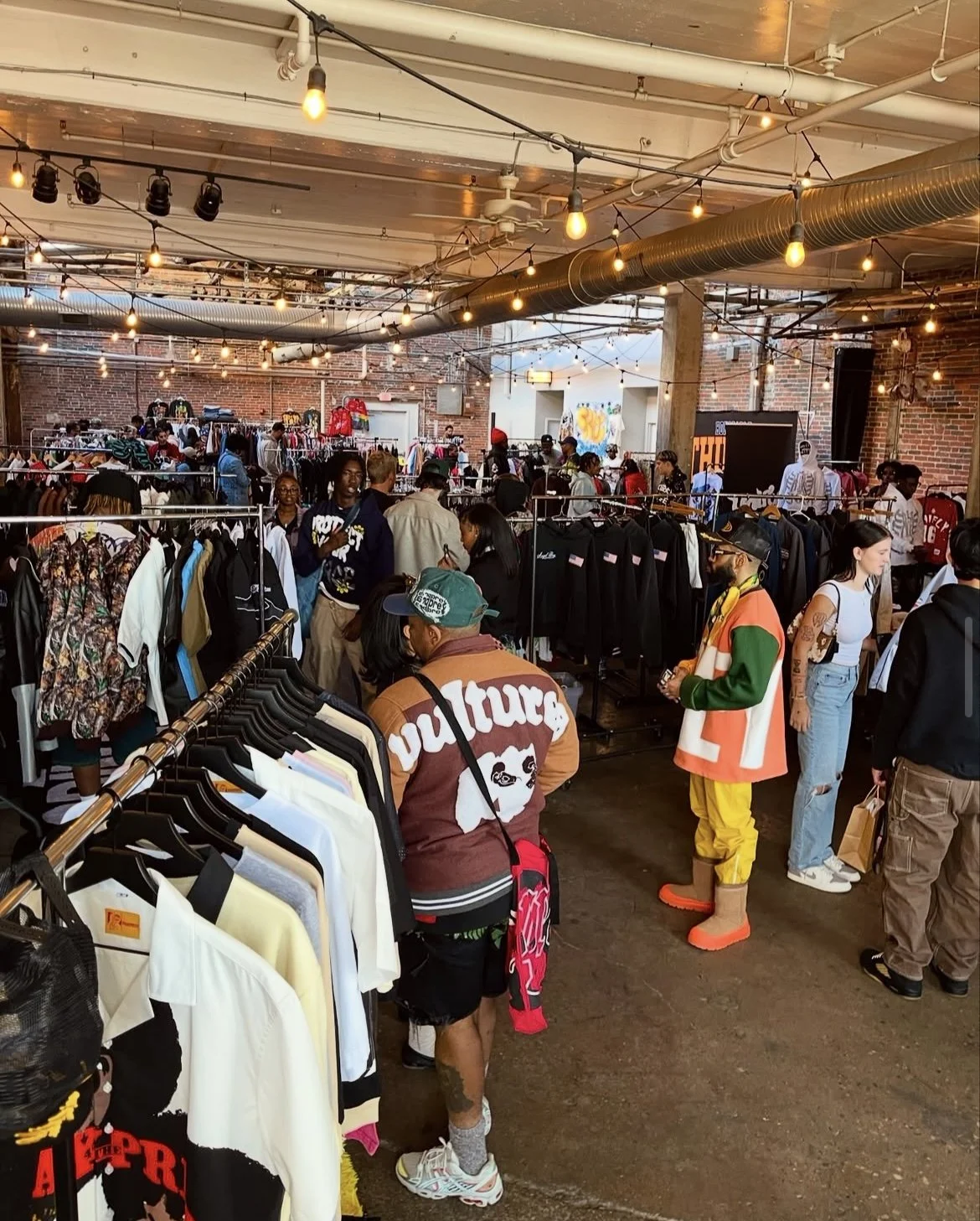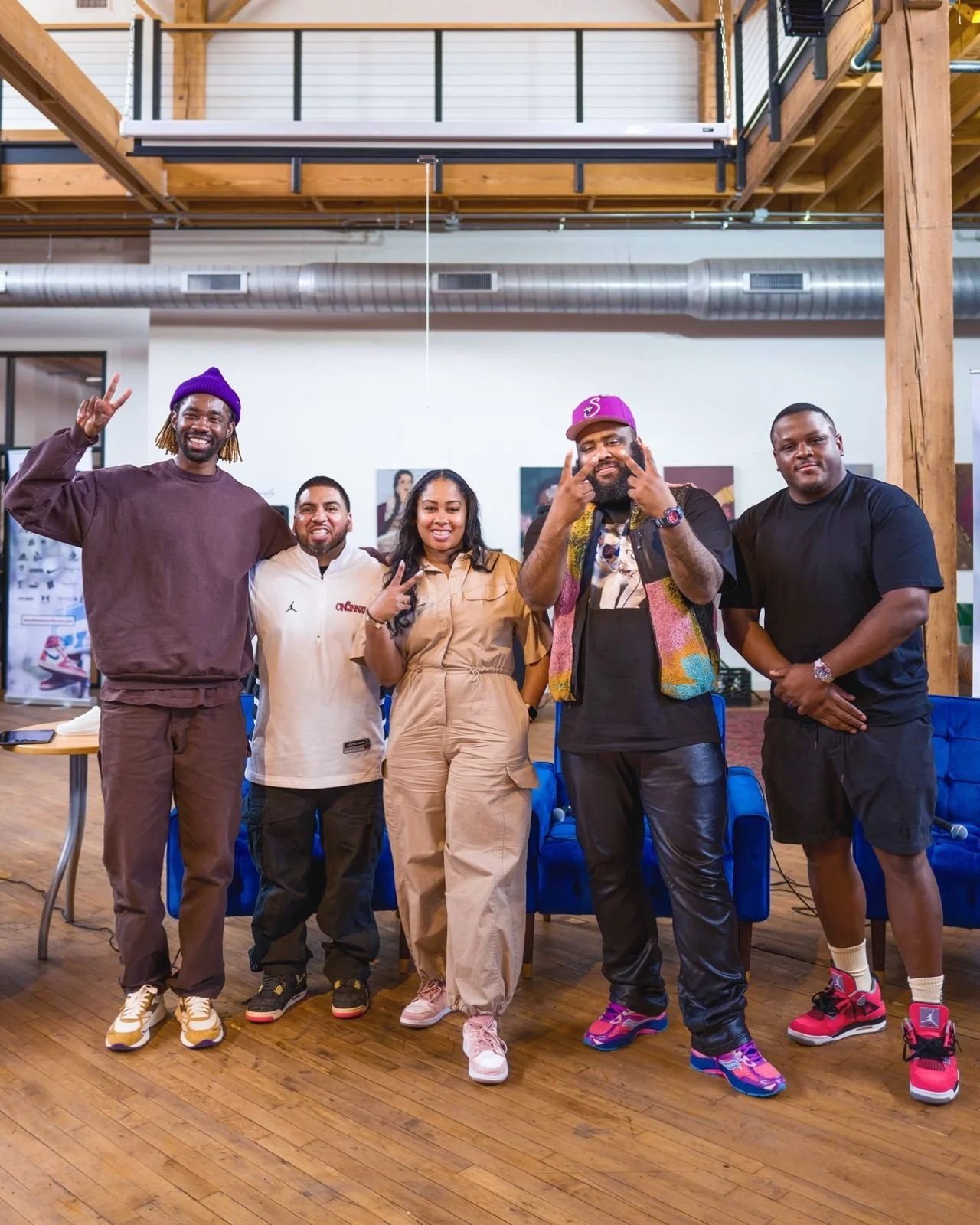James teaching at workshop at Parson’s School of Design (James Drakeford)
James Drakeford is a Dayton, Ohio–born photographer, creative director, and marketing strategist who co-founded the Streetwear Flea in 2015—a streetwear event that evolved into the nationally touring Streetwear Flea. Now based in Harlem, he balances roles as a photographer, marketing strategist, and cultural connector, driven by a mission to recreate the communal vibe of early sneaker and skate scenes. Under his leadership, Streetwear Flea has expanded from Columbus to major cities like New York and Austin, spotlighting indie brands and sneaker culture.
You studied Physical Education at Ohio State, but your work today lives in the creative space. When did you know it was time to pivot, and how did you trust yourself to make that shift?
JD: I would say there wasn’t necessarily a moment that spoke to me. It was just kind of the natural flow of things and how situations and circumstances presented themselves to me. I graduated in the summer, and usually to teach directly after school, it’s better to graduate in the spring because schools are already hiring by then. So, it was hard for me to get a full-time teaching job right out of college. During that time, I was also working part-time at a sneaker boutique called Sole Classics in Columbus, Ohio. I went from part-time to full-time and eventually started managing the store. There were a host of other fun things going on in my life, and I just kind of rode that wave. In addition to managing the store, I was also exploring photography more. So between doing photography and doing a lot of different things at the store, that kind of just preoccupied my time.
One of Streetwear Flea’s event’s in action (All rights reserved to owner)
Streetwear Flea started off as a big closet sale, based on routine needs to offload shoes and clothing from your closet. And you thought, “Why not create an event, I have friends with the same needs?” When did it click that Streetwear Flea was bigger than you and your circle? And how did your co-founder Dionte Johnson get involved.
JD: I think it clicked for me that Streetwear Flea was larger than just a few people definitely after the first event. The first event was really successful, just based on the energy, the amount of people who showed up, and all the feedback we got. Everyone who participated was like, “When’s the next one? I want to do it again.” So when people are already thinking about the next one immediately, that kind of pressure sets in, but it's also encouraging and inspiring.
Before the event, I wasn’t surprised that it did well. I’m the type of person who’s very calculated in what I do. So when I was putting the idea together in my head, adding all the ingredients. I just didn’t see how it couldn’t be great. I’m thankful it turned out really well, even if I wasn’t necessarily surprised.
In the beginning, some of the details are a little murky, it was ten years ago and I didn’t have the full vision of what it is today. But Dionte, a great friend of mine and the owner of Sole Classics (the store I was managing), had been someone I worked with for a long time. When I started the event, I thought it made sense to form a team. Of all the things I could do, graphic design wasn’t one of them, so I thought it would be great to have him on board as the graphic designer, to help with illustrations and the messaging we needed to promote and market the event. Being the owner of Sole Classics, he also became one of the partners for our very first event. We had three partners in total: Sole Classics, a brand called Ohio Against the World, and another one called Made by NGO. That’s kind of how he got involved, and how it all started.
“I’m the type of person who’s very calculated in what I do. So when I was putting the idea together in my head, adding all the ingredients. I just didn’t see how it couldn’t be great.”
- James Drakeford
10 years in and you’ve scaled something that started local into a movement with real cultural weight. What were some of the growing pains along the way that often times went unseen?
LL: There have been several growing pains and challenges. From constantly finding ways to improve the event, to not always having the money to produce it, to dealing with people who want to be a part of it, but I don't think it's the best fit—those are ongoing things we navigate every year.
Each event is really about using what we have to create the best experience possible, while also learning from past events. There’s also the business side of running an event, which is a lot more serious, and not always fun, but extremely important. Things like setting fair pricing for vendors and attendees in a way that works for them and also allows us to keep going, that’s a tough balance. In a perfect world, everything could be free and everyone could be happy, but that’s just not the world we live in. So figuring out how to make the most of what we have has probably been one of the biggest ongoing challenges. We've been doing pretty well so far, but there’s definitely a lot of stress behind the scenes that people don’t see when they show up to the event or take part in it.
Panelist for SWF event (Rights reserved to owner)
What is your view of Black culture’s contributions to streetwear? Where do you think Gen-Z fits in when it comes to evolving the game without losing the roots?
JD: I think our contribution to streetwear and sneaker culture is huge because it's something that comes naturally to us. To kind of express ourselves through fashion, and our appearance, it’s more natural or more cultural than most other folks, I would say. Whereas many people that are into it today. It's less natural, but more of a strategy and more of an opportunity. You know, people see, “Oh, GRWM.” That's a popular thing that people are doing online to amass a following, or get paid. And that's not necessarily something that they're passionate about. You know, people, they just see it as an avenue. Whereas for Black folks. We do this out of more of an enjoyment, and an authentic way. So our contribution is always going to be kind of at the top, and the most inspirational, in my opinion.
As far not losing the roots but also being involved in what's going on, I think it comes down to us being more aware and more attentional about the impact that we have. And supporting individuals, platforms, brands that appreciate Black people, and award us for what we do, if they're in position to do so. And to have some type of ownership as much as possible, you know? So when we have our own brands or our own platforms, I appreciate that a lot, and I think the community does as well.
What role does representation play in helping the next generation believe that their dreams and aspirations are truly possible?
JD: I think it plays a huge role, depending on what field an individual is in. Representation is more popular for some fields than others. For fashion, apparel, sneakers, I think there's a lot of representation for people to see others who look like themselves. I mean, it depends on your community too, but fashion is one of the more diverse industries, I would say. Obviously, it's not perfect, and the higher you go, it's gonna be less diverse. But still, we see some of our peers and people that look like us doing amazing things, and have been for several years. And it's encouraging.
But I think now it's really more so a matter of being educated on how to actually achieve these things and being educated on how to do for yourself and do with your community. Because say you look at someone like Pharrell at Louis Vuitton. It's like, we see that example, we see the success, we saw his path, we watched it all happen. Yes, we see what's possible, but how many people is that possible for? Not many. He's been creative director for Louis Vuitton for, I think, a couple years now. So it's like, it's only been possible for one person for two years, and there's millions of people. It's great to see us succeed in high places, but it's even greater for us to see that and be like, “Okay, what can we create together? We see that we're good enough to do anything, so how can we do anything with each other?” We're always going to look to the examples around us, not to replace those examples, but to learn from them. You see Pharrell doing what he's doing, and your goal is not to do what he's done, but to be inspired by what he's done to do something else.
Want to hear more amazing stories like this? Check out our “More of Us” series! If you want to connect with James and support the work he is doing, follow him on Instagram, you can support his business by clicking here.



